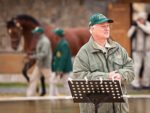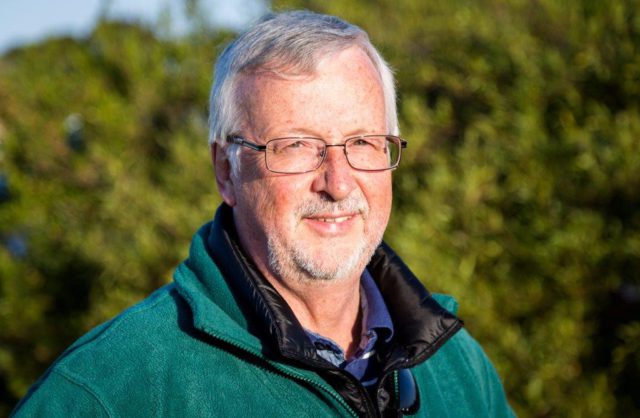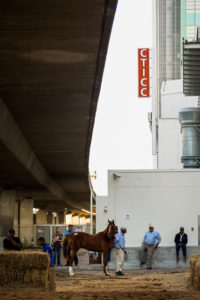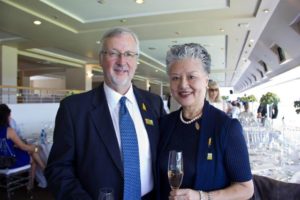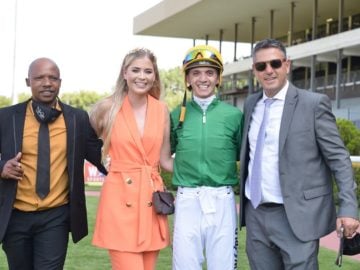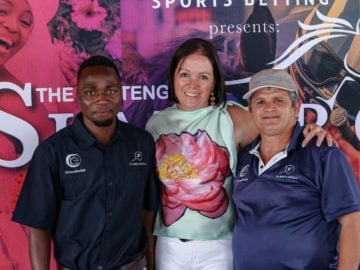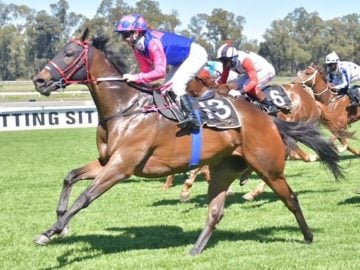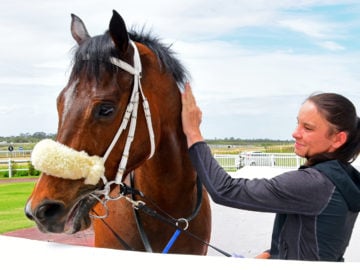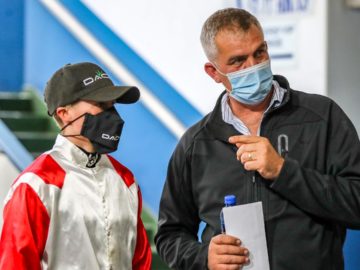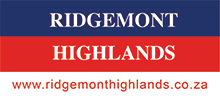There are not many bloodstock people outside South Africa that take a lot of notice of us, but those who do, do it with a passion.
One of those people is bloodstock consultant and manager David Allan who is also an owner and breeder in South Africa. He – supported by pedigree and stud book expert Judy Brannigan who also breeds here – recently published ‘Thoroughbred Thoughts’, highlighting in public a number of issues that should be high on every racing and breeding stakeholder’s agenda. In it, he tackles issues including the current sales schedule, the lack of a next generation – of racing professionals, not just fans – and despairs at why the local industry continues to be inward-looking. All of these have one underlying factor in common – for the South African Thoroughbred industry to continue developing in a progressive manner, in line with current accepted international standards.
David has been involved in the local industry for approaching 15 years. He is kind and affable, but is very serious when it comes to his dedication to safeguarding and developing South Africa’s presence in the global market. “I want the SA Bloodstock industry to be well regarded internationally, not seen only as a sun-soaked horse boutique.”
Part 1 Status
Perhaps the best place to start is his and Judy’s concern for our Part 1 status in the International Horseracing Federation’s Blue Book, also known as the International Cataloguing Standards Book. The book was established in 1981 and is maintained by the International Race Planning Advisory Committee (IRPAC), in conjunction with the Society of International Thoroughbred Auctioneers (SITA). Racing countries were divided into 4 parts, with the world’s major racing countries classified as Part I and lesser jurisdictions given Part II or Part III status and Part IV covering jumps racing.
A Part I country’s racing activity has to be deemed of sufficient stature in terms of number of horses competing, number of races contested, and purse monies distributed, to justify their classification as being among the world’s major racing countries. Catalogues will show their Group/Grade 1 races as Gr.1. That is not the case with Part 2/3 countries, with the exception of some races that are internationally contested.
South Africa was accorded Part I status in October 1985, a classification it still holds alongside Argentina, Australia, Brazil, Canada, Chile, France, Germany, Great Britain, Ireland, Italy, Japan, New Zealand, Peru, the UAE and the USA. It may come as a surprise to some in South Africa that Hong Kong has been added to that list, promoted from Part 2, only last month. This resulted in substantial part from the international raiders visiting Hong Kong to run in their major races – something that currently cannot happen in South Africa.
David warns that we must also keep an eye on the up and comers. Korea has recently been promoted to Part 2, thus having the same status as Singapore. But in Korea they have ex Coolmore stallions and have been buying yearlings from Australia for a number of years. Japanese youngstock are not affordable but why, he asks, should Korean-breds not also be attractive to South East Asian racing markets on their doorstep?
Industry asset
“Twenty to twenty-five years ago, Japan did not feature as a major player. Now they breed some of the best horses in the world and are solid Part I players.
South Africa’s Part 1 status should be regarded as an industry asset and protected for the sake of the industry as a whole.
It’s something to be conscious of and not taken for granted. Imagine what would happen if we lost our Part I status and then the export protocols were sorted out?” he asks.
“While we are marooned by the EU ban”, says David “it is crucial that we maintain a professional profile overseas. The ban, the Rand and the current economy’s effect of obscuring our presence is the predominant impression – or lack of impression – abroad”. His activities when overseas are largely channelled to exactly that effort through emailings tailored for overseas readership about South Africa and many regular conversations at northern hemisphere sales, on racecourses and training grounds. He is widely recognised as a “South Africa link” and has brought substantial overseas investment into breeding here as well as introducing owners through CPYS purchasing and small shares in racehorses. “Some exciting high priced purchasing in Europe is of course taking place. My goal is to prepare for more mid-range two-way cross trading in breeding stock”.
“Fortunately we are making strides with AHS, so with a bit of luck, things will change and when the markets open up, we want to be in that swim, but that will require us to do some planning and ensure that we keep growing and developing over the next 5-10 years.”
Shrinkage
David cites the recent year on year decline in local median yearling sale prices and says,
“To me the main message here is shrinkage – of owners, breeders, sales prices and the South African market in general.
That’s something we need to guard against in order to maintain the health of our industry and our share in the global market.”
He has some thoughts on how to achieve this. “There is universal agreement that we have far too many yearling sales and with sales companies vying for custom with generous socialising opportunities, we are diluting their core function. Having all these sales dates inevitably means clashes with other international events as was evidenced recently with BSA and CTS having newly scheduled sales to clash with York, Tattersalls Yearlings and Tattersalls Foals. Right now the collateral damage is limited to annoying a few overseas professional players in our game. Having planned to bring a few people to a ReadytoRun Sale here and seen the date put back into a slot which visitors certainly cannot make, I can only recommend that a streamlined future sales programme takes such things into account in case we really do grow”.
Less sales
“We don’t need any more than 4 yearling sales and my suggestion would be firstly the CPYS – vendors have learned how to prepare for it, it is an elite sale and a logistical masterpiece and if the likes of Coolmore and the China Horse Club support it in partnerships, that can only be a good sign. Then a single Cape March sale – not both Val de Vie and CTS. It has to be a regional sale, but without sales race expenses attached. Most trainers need to buy on a budget, and regional sales are a good way to address the middle section of the market. Those are the sort of horses that keep the smaller owners in the game, they fill fields and very often, they win races. Keep the compulsory sales race expenses out and the sale will flourish.”
Next on his list is a single sale in Johannesburg. “I don’t mind who manages the sale – whether it be TBA in its new phase, CTS or even a coalition, but surely the figures show that one consolidated sale, not two fragmented ones is logical.” And then lastly, “a combination of KZN Yearlings and the TBA 2 year old sale rolled together.”
Mare Sales
“I feel that both the mare sale in Worcester as well as the new CTS sale are developing in the right way,” and he is particularly complimentary about the elite mare sale concept, bringing in European mares in foal to European stallions Southern Hemisphere time. “How marvellous that we have access to those bloodlines in this country when the mares are sold.” However, there is more that can be done. “If you buy mares on a UK, Irish or French sale, the horses automatically have certificates for CEM, EVA and a Fillies Examination for Breeding Certificate. That doesn’t exist in South Africa. Maybe the first two are more important in the case of immediate export, but a Fillies Exam Cert is crucial to an overseas investor and is not always easily achievable at the sales ground. Simply put, the lack of such a certificate is scary and we have to warn people that there will be a very short window on the sale ground to have an examination done. Attention to small details like these can streamline and polish to the entire process.”
Import protocols
While most people bemoan export restrictions, David thinks the importing regulations could also do with an overhaul. “I sometimes wonder whether it’s only me? And by ‘it’, I mean the way our horses are penalised in wear and tear during the import process, plus cost and restriction from owner access. As an example, if I were to purchase a filly for stud in the UK in July and cover her Southern Hemisphere time, she would go into quarantine in December for 30 days and fly in January. Then there is another 30 days quarantine on arrival. Why? If a mare arrives in foal, she has to “serve time” in lock down, not farm-life quarantine, then be shipped to one of a prescribed number of mare stations until she has foaled down and then has to serve another 30 days after foaling. So you could easily not see your mare for over a year! No wonder breeders often have a tough time with imports acclimatising”.
Generation next
“We have a limited population and as statistics bear out, there is constant slippage. We lack a new generation, not just racing fans, but layers of young professionals coming up through the ranks. We need to gather together bright young industry minds and get them to give their input.
We need to create activity, business and careers and international interaction to sustain the industry going forward.”
David also has proposals for how the sport of horseracing can extend its outreach into the sporting nation that is South Africa.
Stallions and Mares
“My wife Yoshi and I own 15 broodmares in the Cape, 12 outright and 3 in partnership. I directly manage another 20 for overseas mare owners here and consult for others. I also manage a portfolio of six stallions, which I’m both passionate and cold-bloodedly optimistic about.” His stallion roster includes Gitano Hernando, Where’s That Tiger, Elusive Fort, Lateral, Alado and the newly launched Fencing Master.
“The thing about Fencing Master is his second in the Dewhurst Stakes, which pegs him more or less at European Champion 2yo level,” enthuses David. “There are very few stallions in South Africa with a female line like this and what made the day at his launch was the weanling and yearling parade. We are very excited about him.”
However, each of the stallions on his book comes with a story as well as David’s deep personal belief and enthusiasm.
So what makes David so dedicated to the South African cause? “I’ve always been passionate about South Africa. There’s a special energy about the place and I’m happy to have the opportunity to be involved here. I probably spend 6 months in the UK and 6 months in South Africa. It’s my home from home.”
‹ Previous
